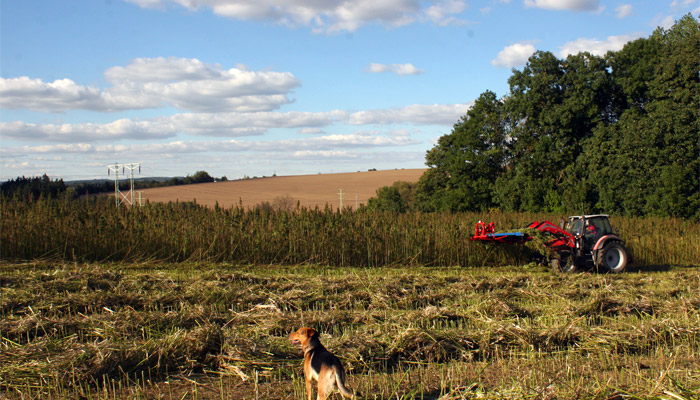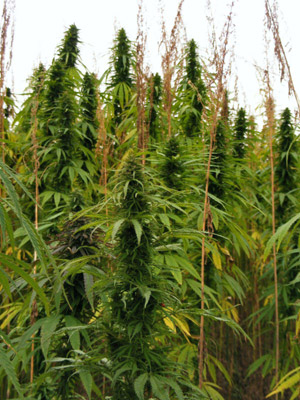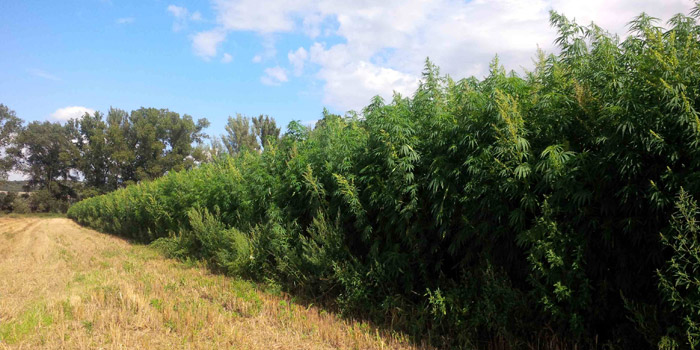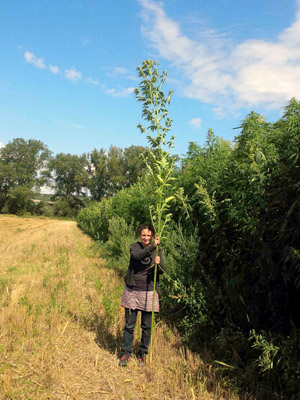By Hana Gabrielová

Graduated from the Faculty of Agriculture, with thesis on the topic: “Options cultivation and use of hemp in the Czech Republic”. In 2005 she received the accreditation programs of the Ministry of Agriculture as adviser specializing in organic farming and cultivation of hemp. Since 2000 she is an active member of NGO Konopa, which educates the public and professionals in the potential of using hemp. In 2011-13 she was a member of the Steering Committee of international organization, ENCOD, and is a member of the Petitions Committee on Petitions for medical cannabis in the country. Between 2010-2012 was organizing profesional conference on Cannafest in Prague. Since september 2010, she is working as a managing director of Hempoint Ltd. focusing on growing organic hemp. In 2013 was the cofounder of KOPAC, the czech patient association for cannabis treatment. In 2016 started work on standards for cannabis growing (Patient focus certification) under International cannabis and cannabinoids institute (ICCI).
Hemp and its sexier cousin marijuana both come from cannabis sativa.
This one plant species embraces thousands of different cultivars and strains, bred for different purposes.
Hemp has been very closely connected with human history for centuries, satisfying a variety of needs. Hemp fibre, seeds, flowers and stalks have played a part in major historical events throughout the world. Columbus, for example, could never have made it to America without strong hemp ropes and sails. And throughout history, education in China was furthered by the use of cheap hemp paper to disseminate information.
Finally, hemp has provided medicinal relief to millions over the last 5,000 years.

However, in 1961, the United Nations placed hemp on a “black list,” resulting in a global ban on the growing of the crop. THC (the psychoactive cannabinoid content) was discovered in 1964 and joined the list of prohibited substances in 1968. It was not until 20 years later that scientists in France, which has a strong tradition of hemp growing, developed strains with a very low THC content, allowing the plant to be used once more for such things as food, fabrics and building materials etc. with no legal complications. That scientific development was coupled with strong lobbying in the European Parliament, eventually resulting in new regulations allowing EU countries to grow industrial hemp with a maximum THC content of 0.3%.
Industrial hemp is currently defined as comprising strains with less than 0.3% THC (some countries set the maximum at 0.2%). Strains under this 0.3% level qualify to be registered in the EU Common Catalogue of agricultural plant species that can be grown as an industrial crop.
Legal status

Legislation for growing hemp is still not common in all EU countries. In some countries, farmers have to acquire a special license; in others, they need only inform local authorities and governmental departments that they intend to plant a hemp crop. Broadly speaking, across the EU hemp growers are required to use seeds that have been certified by seed breeders who guarantee low THC content (0.3%). Seed sellers are required to provide documentation in a process that establishes a form of legal protection for growers against prosecution.
In the field, hemp and marijuana are barely distinguishable. Marijuana —known by a variety of slang terms such as “ganja,” “weed,” “pot,” etc.– comes from the dried flowers of female cannabis plants that contain (technically) more than 0.3% THC, although most marijuana used for recreational and medicinal purposes is taken from plants with much higher THC concentrations. Medical marijuana has been legalized on a limited basis for growth in a few member states, under government supervision.
While the EU has yet to recognize marijuana as a legal substance, European-wide rules regarding industrial hemp basically define it as that with less than 0.3% THC.
Potential of cannabis
Although the prohibition on marijuana in place since 1961 has hindered cannabis research, nonetheless many benefits of consumption of the plant have been identified, especially for medical uses.
Patients mostly come to cannabis because they have no other choice or because they have found that it works better than conventional medicine with no risk of side effects.
Medicinal applications of cannabis include treatment for:
- Glaucoma
- Epileptic seizures
- Cancer
- Anxiety reduction
- Slowing the progression of Alzheimer's disease
- Easing the pain of multiple sclerosis
- Possible help with other types of muscle spasm.
- Lessening the side effects of Hepatitis C treatment and increasing the effectiveness of treatment.
- Treatment of inflammatory bowel diseases, including Crohn's disease.
- Arthritic discomfort.
- Tremors in people with Parkinson's disease.
- Post Traumatic Stress Disorder (PTSD)
- Helping to protect the brain after a stroke.
- Eliminating nightmares.
- Relieving nausea from chemotherapy, and stimulating appetite.
- Helping to reduce alcohol consumption
To give a fuller picture, it should also be noted that cannabis entails some risks for mental health.
- It can have negative effects on cognitive function
- It can have negative effects on short and medium-term memory and concentration
- It can overly impact emotions
- It can heighten depression or agitation in predisposed consumers
- It carries a risk of psychiatric disorders
The potential of hemp
While the hemp industry has made great strides in recent years there is still insufficient awareness among policy makers, civil servants and government officials. This means that legislation lags behind, as do standards for hemp farming and processing. Inconsistencies in the methodology used for analysing samples and guaranteeing contents is also holding back progress.
Yet hemp offers a wide variety of benefits ranging from job creation and economic development to specific medical and well-being applications. It also makes excellent textiles, and offers a sustainable alternative to the construction industry.
Hemp in the field
As a crop, hemp is eminently sustainable; it actually absorbs CO2, and has proven effective as a remedy to deforestation.
Environmental benefits of hemp agriculture:
- It improves soil structure
- It works as good bio regime for farmers; no chemicals needed
- It protects the soil against erosion
- It is an ideal rotation crop
- It prevents deforestation - hemp can replace timber-based products

Economic development and hemp
Because hemp, if properly processed, can be a high-yield crop, it holds out promise for development in depressed rural areas. It also offers an excellent opportunity for developing highly localized “distributed” economies where neighbours do business with each other. As an excellent rotation crop it can help diversify local agricultural production and provide local jobs.
Medical: Cannabidiol
It is interesting to note that demand for cannabidiol (CBD), which comes from low-THC hemp plants, has proven effective in treating some illnesses and health problems. As a result, the CBD market has grown exponentially in the last two years — accompanied by a lot of media hype. CBD is derived from hemp plants with a high percentage of CBD.
Much work remains to be done in the development of CBD, since up to now most industrial hemp grown in Europe was destined for the seed oil and fibre markets. The list of approved European hemp varieties, which now numbers more than 50, does not contain even one strain bred for CBD.
Green matter and seed oil markets
Hemp flowers have applications in herbal health and beauty products and in the food market, especially in green tea. Seed-based hemp foods offer a balanced content of important nutrients.
Hemp flowers and leaves from legal hemp strains do not contain psychoactive THC, but there is cannabidiol (CBD) present – and studies are increasingly demonstrating its positive effects on the immune system. It has proven effective for insomnia, digestive problems, headaches, joint pain, and respiratory ailments.
Essential (seed) oil is used as a flavouring additive in the food industry, but it has found its place in the cosmetics industry as well. A mixture of essential oil with hemp oil obtained from seeds is used for massages with relaxation and anti-inflammatory effects.

Hemp construction and more
Hemp shives and hurds –the core of the stem– can be used for everything from animal bedding to car interiors. The main market for shives is still mostly for bedding for horses and other kinds of animal. Construction with hempcrete (a combination of hurd and natural lime) results in truly green building, and a healthy environment that actually absorbs CO2.
The market for hurds used in bio-composites for interior auto parts has proven stable. Companies like Audi, BMW, Mercedes and some of the French carmakers are using bio-composites in the interiors of their mid-range and luxury size vehicles. Some contain as much as 25 kilos of hemp fibre. These are price-competitive with traditional plastics and have obvious environmental benefits.
Hemp has long been used in textiles, ropes and paper.


